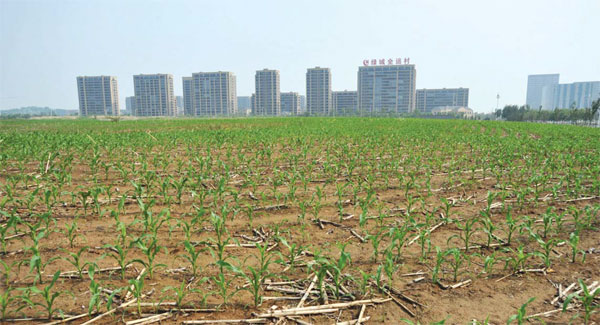The future of China's 'ghost cities'
Updated: 2015-07-03 07:14
By Wade Shepard(China Daily Europe)
|
|||||||||||
Once-empty cities built with a wave of urbanization in mind are filling up at surprising rates
A ghost city is "an abandoned city with depleted resources, a high vacancy rate, few inhabitants, or that is dark at night" due to a lack of occupants, according to China's National Science and Technology Department's Terminology Committee.
Although many of China's new urban developments may at first sight appear also to be ghost towns, that term doesn't apply to these places. A ghost town is a place that has died. What China has is the opposite of ghost towns - it has new cities in the process of coming to life.
|
High-rise buildings in one of China's new towns in Liaoning. The ghost city critique usually amounts to little more than an analysis of a temporary phase of development. Provided to China Daily |
Modern China's urbanization story begins in the early 1980s, when large swaths of rural land across the country began being rezoned as urban en masse, and larger cities started being granted authority over prefectures.
At that time, only 180 million Chinese lived in cities, and there wasn't an urban expanse in the country with more than 10 million people. But by the early 2000s, China's urbanization ambitions were kicked into overdrive, as nearly every city in the country began rapidly expanding outward and completely new cities and towns started sprouting up in the expanses between them.
Urban development across the country began taking on the appearance of a free for all. In a 2013 survey, China's National Development and Reform Commission set out to discover just how many new urban areas were actually being built. Their findings: In just 144 of China's cities, more than 200 new towns were either being constructed or were in the planning stages.
China is now home to one-fourth of the world's 100 largest cities. It has 171 cities with over a million people, and also contains 29 of the 75 cities that the McKinsey Global Institute predicts will be the most economically dynamic by 2025. There are now 730 million urban Chinese, and the nation's National New-type Urbanization Plan aims to keep this number rising. Over 250 million more Chinese are expected to be living in cities by 2030.
So with all of this urban activity and migration to cities, why do so many of China's new developments appear so empty?

China's urbanization program has been forced into motion by a fiscal policy that all but demands local cities expand to remain economically solvent. According to the World Bank, China's cities must fend for 80 percent of their expenses while only receiving 40 percent of the country's tax revenue, so land sales are often used to make up the difference.
Land is bought by cities at the low rural rate, rezoned as urban, and then sold to developers at the high urban construction land rate. The profits are huge. The Ministry of Finance says land sales raised $438 billion (394 billion euros) for China's local governments in 2012 alone. Corruption and errant spending aside, this money is often essential for sustaining urban infrastructure, funding public institutions and facilities and various other social programs. Cities expanding beyond their current needs are all too often a built-in inevitability.
When developers purchase these fresh plots of urban construction land, they are required to build something almost immediately. They can't just sit on them and wait for the surrounding area to economically ripen. The prevailing attitude among developers is that they need to get in early to make a profit, which often results in building in new areas that lack any semblance of supporting urbanization or sizable enough populations.
After a core downtown and an array of housing are created in a new area, what comes next could be called the chicken or egg scenario. Nobody is going to move into a place that lacks public services such as healthcare, schools, functioning shopping centers, places to work, public transportation, and highway and rail links, and local governments are hesitant to produce this infrastructure in areas where there are not yet many people. While the Chinese will buy property in new development areas where there isn't yet an economic or social pulse, few will actually move in until it starts showing some very convincing vital signs.
Although this recently has begun to change, rampant real estate speculation and investment has often hindered the process of filling up new development areas with inhabitants. Up until relatively recently, China's housing market has generally maintained a strikingly upward trajectory. It has allowed many people to make a lot of money investing in real estate, and has also turned home buying into a type of brick-and-mortar savings fund.
Although the sure-shot economic stimulus of masses of ready homebuyers kept the wheels of China's new city movement spinning, it often led to huge amounts of the housing stock being purchased by people with no intention of living in it, which often drove the prices higher than what those who actually wanted to move in could afford. This has had the effect of making many of China's new cities take on the appearance of ghost towns. This is something that in large part has been corrected by new government policies to restrict real estate speculation, curb the laundering of illicitly received funds in housing, and to open up alternative avenues for investment, which has lowered or leveled off the cost of housing in much of the country.
Although there are many built-in factors that inhibit the vitalization of many of China's new urban areas, the country has the means to break this inertia. If there is one thing that China has a lot of, its people, and the country maintains ways of moving these people around the country to live in new areas that are in the process of vitalization.
One of the main ways that large-scale new areas are stimulated is through the building of university towns. These sprawling networks of multiple college campuses are able to attract hundreds of thousands of students and staff members. Dachang, Songjiang and Lingang in Shanghai are good examples of this, as are Longzihu College Park in Zhengdong, Chenggong in Kunming, and Longgang in Shenzhen. Another strategy in bigger cities is to build a central business district and then force its occupation by movement of the headquarters and offices of state-owned banks and other businesses, as was done in Shanghai's Lujiazui, Guangzhou's Zhujiang and Zhengzhou's Zhengdong.
A third strategy for sparking a population in a new area is to move in government offices and offer housing subsides and incentives to the officials and workers to get them to follow their job. Move the feeding trough to get the cows to follow.
Eventually, as people trickle in through free will or fiat, China's new cities begin developing a social and economic base. Although there are almost always bumps in the road, political and economic mishaps, and delays, essential infrastructure generally gets built, public institutions are created, shopping and entertainment centers open, and nearly everything that's needed or wanted to sustain life in modern China gradually becomes available.
Some of China's most notorious ghost cities have been attracting considerable numbers of residents, according to a report by Standard Chartered. From 2012 to 2014, they found that Zhengdong New District's occupancy rate doubled, while the population of Zhenjiang's Dantu quadrupled, and houses in Changzhou's Wujin district grew from 20 percent to 50 percent inhabited. When we consider that many of these new cities are packed full of high density housing, large vacancy rates can be sustained while still having a lively civic pulse and an adequate amount of economic activity. An urban area with hundreds of 30-story high-rises that are 50 percent vacant still has a large number of people.
While not every new city or town in China will be successful and not every patch of countryside will sustain an array of skyscrapers, if given enough time, most do develop sufficiently into vitalized urban areas. China's new cities are generally not being built for today or even for tomorrow, but for decades from now, when the country's urban population is predicted to top 1 billion and a network of mega-cities stretches across the land.
Because China's new cities are generally built on 20-year timelines - a period of time that none of them has yet eclipsed - any claims to their being ghost towns are cast prematurely. To put it simply, China's new cities are new, and the ghost city critique usually amounts to little more than an analysis of a temporary phase of development as China builds new cities for the deluge of urbanization that was intentionally set in motion.
The author is writer of Ghost Cities of China.
(China Daily European Weekly 07/03/2015 page9)
Related Stories
Planned district better than urban sprawl 2015-07-03 07:14
'Ghost town' greets new industries 2015-07-03 07:14
Banishing ghosts 2015-07-03 07:14
Today's Top News
Power Link generates momentum with UK base
Russians will 'surprise' in victory parade: Ambassador
China-France partnership 'will benefit all'
Greece in billions of financing gap over next three years
Securities regulator fires up new policies to stem market plunge
Putin to meet Iran's President Rouhani at SCO summit next week
The future of China's 'ghost cities'
China stocks retreat in biggest three-week plunge since 1992
Hot Topics
Lunar probe , China growth forecasts, Emission rules get tougher, China seen through 'colored lens', International board,
Editor's Picks

|

|

|

|

|

|







